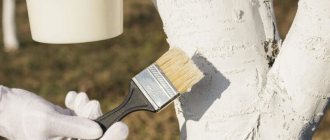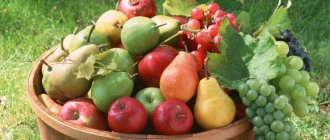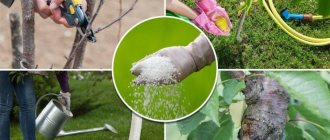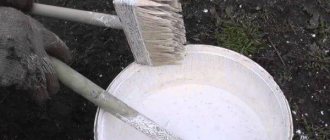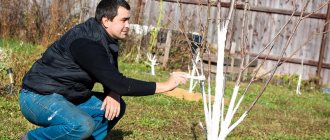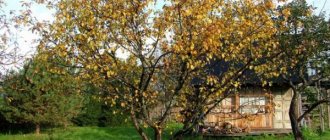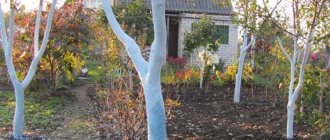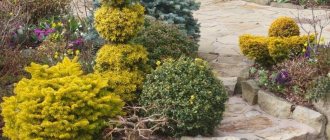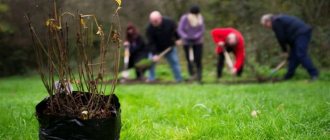The benefits of whitewashing
White trunks look very decorative, but aesthetics are not an important function of whitewashing. This procedure is designed to solve the following problems:
- Protection from the negative effects of the sun . Ultraviolet radiation dries out the bark, causing burns, which leads to cracks. Such damage causes weakening of plant development, development of pathogenic microorganisms, and the appearance of pests. White solutions are used that effectively reflect the sun's rays.
- Reducing the dangerous consequences of sudden temperature changes . During the period of daytime thaws and significant cooling at night, the tree bark bursts, exposing the wood and opening the door for a viral or fungal infection. Whitewashing neutralizes temperature fluctuations, since the trunks heat up less due to the reflection of the sun's rays.
- Prevention of damage by rodents and harmful insects . The composition of the products used to whitewash tree trunks includes substances that repel pests.
- Rot protection . With high humidity, wood tissue often develops a rotting process. Timely whitewashing can reduce the dangerous effects of harmful microflora and ensure high-quality plant development.
Whitened apple tree trunk
When to whitewash trees
Autumn (October-November) whitewashing is considered obligatory , since during this period harmful insects look for winter shelters and often climb through cracks into the depths of the tree bark. In addition, in winter rodents become more active and can completely destroy especially young trees with thin bark. Autumn whitewashing helps protect against sunburn at the end of winter and early spring, and also increases the resistance of the bark from cracking during temperature changes.
Experienced gardeners practice re-whitening in the first ten days of March. This enhances protection against sunburn.

Despite the fact that it is recommended to whiten trees in the fall, this can also be done in winter, as long as the weather is dry
Benefits of paint
Modern means have a number of advantages over proven, but rather outdated types of processing:
- They guarantee protection not only from insects, but also from rodents.
- Reliably protect the tree trunk from possible sunburn.
- The paint is suitable for absolutely any plant.
- Moisture resistance increases significantly.
- You don't have to worry about trees in severe frosts.
- Whitewashing with paint can be used in places where branches have been cut or broken instead of special means.
- Protects the trunk from harmful insects that settle in the folds of the bark.
- After treatment, you can forget about diseases such as fruit rot, rust, scab and many others. There is an option, in addition to standard whitewashing, to treat the entire crown of the plant with paint diluted with water (1:10) using a sprayer. This will not only prevent diseases, but also protect against acid precipitation and the appearance of lichen on the branches.
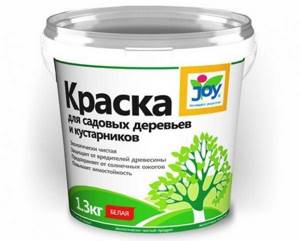
Preparatory stage
The quality of whitewashing depends on the correct preparation of the trunks of the trees being treated.
- First, dust, stubborn dirt, and exfoliated dead bark particles are cleaned. Remove lichens and overgrown mosses. The rough bark of old trees is cleaned with a wire brush. If young plants no older than 10 years are to be treated, then use a medium-density sponge .
- The pre-trunk circle is covered with a film on which all the elements to be cleaned are collected. They need to be burned, which will get rid of possible diseases and wintering pests .
- The trunks are then disinfected. For this purpose, dissolve 25 g of shavings or laundry soap powder in 5 liters of hot water. While stirring, add 800-1000 g of sifted wood ash . Soak a soft rag or sponge in the solution, and then apply the liquid to the entire surface of the trunks and large branches. You can prepare a one percent solution of iron sulfate, but it is used at intervals of 3-4 years, since this substance accumulates in wood tissue and can weaken plant development .
- Cracks, cavities, frost holes and other damage found after disinfection are cleaned down to the wood and covered. For this purpose, garden pitch or special means , for example RanNet biotechnical paste.

Whitewashing of fruit tree trunks is done to a height of 1 to 2 meters
How can you whiten trees in spring? Composition of solutions
The composition of solutions for whitewashing trees, as a rule, includes three main components:
- White coloring matter - lime, chalk,
- Adhesive – PVA, clay, milk, laundry soap,
- Useful substances - copper or iron sulfate, manure, droppings.
The listed components are most often included in recipes for preparing solutions for whitewashing trees. You can use any recipe, or buy ready-made garden whitewash (which is prepared using the “just add water” principle), special paint or spray whitewash. It is necessary to whiten not only the trunk, but also the forks and bases of large branches.
Many gardeners have already managed to evaluate in practice this alternative to traditional whitewashing - elastic garden bandages that are used to wrap tree trunks. Such bandages “breathe” perfectly, allow moisture to pass through and protect from the sun.
It is generally not recommended to whitewash young trees, and here another new product comes to the rescue - garden non-woven fabric. Spandbond, familiar to modern summer residents, can also protect the trunks of fruit trees from the sun and frost damage (also very important for young plantings).
How to whitewash trees
There are different opinions in the selection of products aimed at whitewashing. Conservative gardeners believe that nothing exists better than lime for these purposes. Innovators, especially young people, prefer more convenient paints that do not require preparation. Meanwhile, each protective agent can have positive and negative characteristics .
Lime
The advantages of traditional lime include the following qualities:
- Environmental Safety . Since lime is a natural material obtained by burning carbonate rocks, there is no harm to the environment when used.
- Low price . However, there are a number of disadvantages of lime whitewash:
- A short period of preservation of the dried calcareous layer on the bark . With frequent autumn precipitation, the whitewash practically disappears by the beginning of January. In winter, whitewashing can be repeated only during the thaw period, which is quite problematic if gardeners do not live in the country all year round.
- In its pure form, lime is a good protection against frost damage and sunburn . To give it the properties of an insecticide that can fight pests and prevent the development of diseases, it is necessary to introduce special additives. More often their role is played by vitriol - copper or iron.
Lime whitewash is not used until young trees enter the fruiting stage. This is due to the ability of lime to absorb moisture, which leads to drying out of the thin bark of plants.
Water-based paint
According to the main characteristics, water-based paint is identical to lime. It does not contain components that protect plants from harmful insects and diseases.
This type of whitewash prevents cracking due to temperature fluctuations and sunburn. But unlike lime, the water-based coating lasts until spring , if whitewashing was practiced in the autumn season.
Acrylic paint
The popularity of acrylic paint when doing tree garden crafts is due to many benefits that you should definitely know about.
Pros of acrylic paint:
- The paint layer adheres well to the bark.
- The protective coating lasts for a long time even in inclement weather.
- The paint contains compounds that repel pests and protect plants from diseases.
- There is no need to mix the components, since the paint composition is sold in finished form.
- After drying, a coating is formed that allows air to pass through well and helps retain moisture in the bark, so it does not harm even young trees.
- Unlike lime, you can apply just one layer.
Of the minuses, only two points can be highlighted:
- Quite a high price compared to other drugs.
- Labor-intensive application process
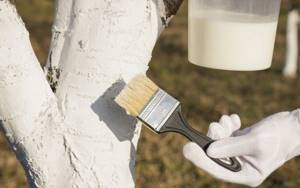
Whitewashing wood with acrylic paint
Timing of work
In the fall, trees need to be whitened before severe frosts: at the end of October - beginning of November (this is the main whitewashing).
In the spring, whitewashing is carried out again: in February you can already start, but it is also possible to do it later - in March or early April. And if the autumn whitewashing did not take place, then the trees should definitely be whitewashed in February, when there is no severe frost (at least minus 2-3 degrees during the day).
Favorable days for whitewashing fruit trees in the spring of 2018:
- March 3 (until 11:22), March 13 and 14, March 25 (from 14:46), March 26;
- April 9 (from 10:51), April 10 and 11 (until 22:41).
Unfavorable days for working with plants:
- March 2, March 17 (until 21:58), March 31;
- April 16 (from 12:52), April 30.
Preparation of solutions
A variety of means are used for whitewashing, so if necessary, it is easy to choose the appropriate option.
Lime mortar . You can use an available recipe, for which you need to purchase quicklime.
Cooking sequence:
- Stir 300 g of wheat flour in 300 ml of cool water until lumps disappear.
- Pour the flour mass into a saucepan with 1.5 liters of boiling water in a thin stream with active continuous kneading. Immediately remove the pan from the heat and cool the paste.
- Pour a liter of slightly warmed water into a separate bowl. Dissolve copper sulfate in it, which you will need 300 grams, and two insecticide tablets crushed into powder .
- Pieces of quicklime - 3 kg are poured into a metal bucket. Carefully pour in 3 liters of water. Keep in mind that a violent reaction begins instantly with the release of a large amount of heat, so you need to stay no closer than 50 cm to the container.
- A long stick is used for stirring. Leave for 30 minutes to cool.
- All that remains is to combine all the components. If required, add more water to obtain the consistency of thin sour cream.

Mortar
Lime suspension . The traditional solution most often used for whitewashing tree trunks is another type of lime suspension.
Cooking algorithm:
- Place slaked lime in the tank - 2.5 kg . Pour in 10 liters of water. With thorough mixing, add copper sulfate - 300 g.
- To give the solution additional density, facilitating good retention on the bark, it is recommended to add 800-900 g of clay or add 200-250 ml of water-based paint . You can use 300 ml of flour paste or liquid casein glue.
- Copper sulfate is first diluted in a separate container with heated water and filtered into a lime liquid through cheesecloth.

For young plants, the concentration of lime liquid is halved
Whitewashing with the addition of manure
Manure is often added to the lime mixture intended for whitewashing the trunks of garden crops. It provides not only the prevention of diseases and strengthening of the protective qualities of the plant , but also replenishes the deficiency of a number of nutritional compounds.
It is recommended to thoroughly mix 500 g of manure and slaked lime with 100 g of copper sulfate (the compound is better known as copper sulfate). Pour in 10 liters of water. Leave for about 30 minutes and then whitewash.
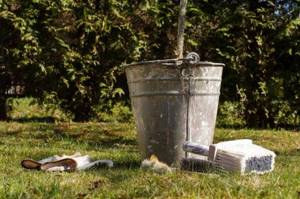
Lime can cause an allergic reaction on human skin, so you need to wear gloves when handling it.
Whitewash
Whitewashing, in addition to giving fruit trees in the garden a decorative appearance:
- in spring and winter it serves as a cover from the sun's rays;
- protects from cracks during sudden winter temperature changes;
- serves as a barrier against insects - pests trying to penetrate under the bark for wintering;
- prevents the dark bark of trees from overheating in the bright March sun and starting sap flow ahead of time.
Time spending
Whitewashing can be done 3 times a year:
- after harvesting and leaf fall in the fall, in late October - early November;
- supporting, renewing, it is performed at the end of winter - beginning of spring;
- another whitewashing is carried out in July.
Autumn whitewashing is considered the most effective. Without it, the effect of the other two is much less, especially since the spring delay in painting or whitewashing the fruit trees in the garden at the same time as the start of garden work becomes useless. The dark trunks of apple and cherry trees heat up in the sun at the end of winter to +11 degrees, which gives impetus to the beginning of sap flow, and subzero night temperatures freeze the juice, the bark cracks, and long longitudinal stripes form on it - frost holes.
You can whitewash trees in spring until the end of March. The white color of timely whitewashing reflects the sun's rays, somewhat delays spring awakening, flowering and, possibly, saves from late morning frosts. Summer whitewashing is necessary if the paint has peeled off and was washed away by rain. If the coating is stable, the need for it disappears.
Preparation
- lay plastic film under the trunk;
- The trunk is cleaned with the blunt side of a knife or a brush from loose bark, lichens, hollows, wounds, cracks to living tissue. This procedure is similar to facial peeling. After removing the dead scales, the tree is overgrown with young bark;
- brush off the dust;
- remove the film with fallen debris and burn it;
- cover cracks and wounds with garden varnish to prevent infections from entering;
- disinfect the trunk with a solution prepared from 5 liters of water, 20 g of laundry soap and 1.5-2 kg of ash.
There are several types of whitewash:
- chalk, whitened mainly, in the spring for beauty, unstable, quickly washed off by rain. In the fall there is no point in painting with such whitewash; in the spring, so that the chalk does not wash off too quickly, adhesives (household soap) are added to the composition;
- slaked lime, slightly more stable than chalk, but has the same disadvantages;
- slaked lime + white clay, the composition is sold in hardware stores, more resistant to precipitation;
- manure, milk, PVA glue are used as additives;
- acrylic paint for whitewashing trees;
- silver paint for whitewashing trees.
- brushes of various thicknesses or paint sprayer;
- brush or knife;
- whitewash or garden paint.
Whitewash recipes
Each gardener makes protective mixtures according to his own taste and desire. A few of them:
- 1 kg of slaked lime is mixed with 0.5 kg of fatty light clay, add a scoop of manure, place in a 5 liter bucket of water, leave for 1.5-2 hours.
- 0.5 kg of lime, 0.5 kg of manure, 100 g of copper sulfate (copper sulfate) are mixed, 5 liters of water are added, infused, and the trees are treated.
- 0.5 kg of slaked lime, 0.5 kg of white clay are diluted in water to the consistency of sour cream + 1 tsp. copper sulfate diluted in 100g of warm water.
Ready-made varieties of whitewash
Water-based paint is also used , which is diluted to the desired consistency with water. It is convenient to use special ready-made whitewashing compositions that already have the necessary additives, which allows them to stay on the trunks longer.
For example, water-dispersed special acrylic-based paint demonstrates good results, which neutralizes the dangerous effects of temperature fluctuations and is designed to protect plants from the appearance of mold, the development of fungal infections, and the colonization of bark by pests. The composition includes a repellent based on natural compounds that repel rodents and harmful insects.

For the fact that you whitened apple and pear trees in the fall, in the summer they will definitely “thank you” in the form of a good harvest
Once applied to the surface of the bark, the paint forms a breathable, vapor-permeable film , which does not interfere with the metabolic processes occurring in the wood and successfully prevents diseases .
Acrylic-based paint has other advantages:
- No unpleasant odor;
- Resistance to washing away by precipitation;
- Maintaining basic protective characteristics throughout the season;
- Use for fruit and ornamental shrubs and tree species;
- Possibility of processing cuts, slices, damage to the surface of the bark;
- Contains special fungicides that prevent the development of fungi, viral infections, and fruit rot;
- High adhesion, ensuring a strong connection of the applied composition with the surface of the bark.
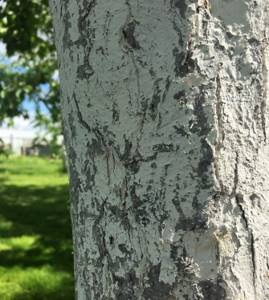
In order for the tree to bear fruit well in the future, it is important to whitewash it regularly and in a timely manner.
Whitewashing with paint
Should I use paint to whitewash garden trees? Here the opinions of gardeners differ: some believe that the paint clogs the bark too much and does not allow it to “breathe”, others see the advantage that the paint does not wash off for a long time, and does not harm the tree. In practice, gardeners quite successfully use the following to whitewash trees:
- Water-based paint,
- Water-dispersion paint VD-KCH-577,
- Special latex paint,
- Acrylic garden paints.
Traditional water-based emulsion will protect tree trunks from burns and frost damage, but special garden paint (acrylic or latex) also contains additives to protect against pests (for example, “Luck” garden paint). The paint adheres well to the bark and lasts longer. But, whatever one may say, it’s chemicals, and the price is higher.
How to whitewash trees correctly
Usually the lower sector of the trunk is whitewashed. If possible, cover the lower tier of the crown, and also cover the skeletal branches in the parts adjacent to the trunks with the composition.
There is no point in covering the entire crown with whitewash, which is impractical and labor-intensive. It is enough to protect parts accessible to rodents, as well as places where harmful insects find shelter.
Choose a dry, windless day . The temperature should not be below 5 degrees. Be sure to protect your eyes with goggles. Wear clothes made of thick fabric with long sleeves, a hat and gloves. To protect the mucous membranes of the mouth and nose, it is recommended to use a cotton-gauze mask.
Distribute the prepared working solution evenly and quite generously over the entire surface of tree trunks and large branches using a wide brush, being careful not to splash the liquid too much. You can use a paint roller or spray gun .
The direction of painting is practiced from the soil surface to the crown. It is advisable to perform several layers, and each previous one should dry well. The minimum painting height is one meter.
On a note
Even when selecting safe varieties of whitewash, it should not be applied to tree seedlings of the current year of planting. This event may slow down further development, so other protective measures are provided. It is recommended to whitewash trees three years old and older with ready-made products, and with lime after the start of fruiting.
Copper sulfate should not be included in the composition of water-based paint , which was chosen for whitewashing trees or bushes in the garden. This additive causes the white tint to disappear and reduces protection from frost and sun.
Fresh natural milk can be poured into the lime mortar to enhance the durability of the coating. to add dyes to the whitewash for beauty . They, of course, will enhance the decorative component, but will reduce the protective characteristics necessary for plants.
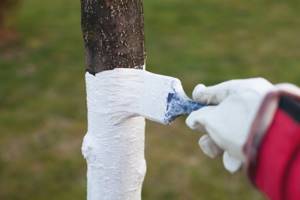
The denser the whitewash layer is applied, the more reliably the tree will be protected from harmful external influences.
They practically stop whitewashing trees that have been growing in the garden for more than 30 years. At their bottom, a thick layer of rough bark is formed, which is less damaged by temperature changes or under the influence of burning sun rays. Cleaning such trunks can cause harm to the tree .
Autumn whitewashing is one of the mandatory procedures for garden trees and large shrubs. Many gardeners re-practice it in early spring. Such an event helps to improve fruiting, as it reduces the risk of damage to the bark by frost and sun, and also serves as a prevention of diseases and pest infestation of plants.
Author of the article: Kamenkov Igor Dmitrievich
- Related Posts
- Ten best ornamental shrubs for your garden
- Methods for grafting an apple tree: time and timing, useful tips for beginners
- Valerian will help against cabbage pests: tested by myself
« Previous entry
